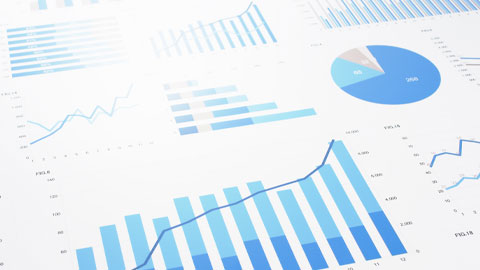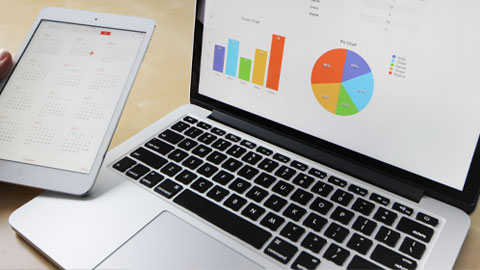A Primer on Predictive Sales Analytics
By Zilliant
Sep 06, 2023
Table of Contents
Read to learn how predictive sales analytics enables B2B sales leaders to accelerate sales with data science and grow accounts as effectively as possible.
B2B sales leaders are tasked with ensuring their teams can earn, retain and grow their accounts as effectively as possible. Even as their teams are faced with large books of business, competing and changing corporate objectives, and the rapid rise of eCommerce, revenue growth is critical — yet challenging. Keeping a sales team focused on the most important opportunities to predict, preserve and grow revenue has never been more difficult.
According to “The Future of Sales in 2025: A Gartner Trend Insight Report,” an exponential rise in digital interactions will break traditional sales models. The report states, “As customers migrate from in-person channels to digital alternatives, chief sales officers (CSOs) must engage in a fundamental mindset shift from leaders of sellers to leaders of selling; sales leaders belong where selling happens.”
As this shift happens, sales teams must undergo a skill set evolution. “Sellers' decision making will be based on data, analytics and AI, not on intuition and experience.” The report also makes an eye-opening prediction. “By 2025, 60% of B2B sales organizations will transition from experience- and intuition-based selling to data-driven selling, merging their sales process, sales applications, sales data and sales analytics into a single operational practice.”
The imperative is clear. Sales leaders must equip their teams with data science-driven solutions to compete and win. Thankfully, sales software has grown more sophisticated to match the scale and complexity of B2B sales.
What is Predictive Sales Analytics?
Predictive sales analytics operationalizes data science-driven insights in a systematic closed-loop process, learning and consistently generating better guidance, delivered directly to sellers for every one of their customer accounts.
Predictive sales analytics can take the burden of manual sales data analysis off the sales team's plate. Instead, predictive sales analytics gives them direct actions to take from day to day, including:
- What products should I be pitching to my current customer base?
- Which customers are most likely to buy which products?
- Which customers are slowly starting to buy from a competitor and will continue to defect if I don't act now?
- Which products should I pitch to win back lost business?
- Which opportunities are most worthy of my time to pursue?
These cases and many others fit broadly under the scope of solutions known as predictive sales analytics. Though the term can mean slightly different things to different people, here's a tidy definition from Hubspot:
“Predictive sales analytics is a type of analytics that uses predictive algorithms and patterns in historical data (typically gathered from a company's CRM or ERP software) to create forecasts, anticipate prospects' behavior and inform better campaign designs for both B2B and B2C companies.”
This blog post will focus on how B2B predictive sales analytics is used to translate customer, product and transaction data into actionable sales insights for sales teams.
Read: Top 10 Revenue Killing B2B Sales Myths and Getting Personal in B2B Sales
Why is Predictive Sales Analytics Vital to a B2B Sales Strategy?

B2B companies thrive on forging deep relationships with customers and nurturing those over time. The cost and risk associated with chasing prospects, while necessary, will rarely be as reliable or important to the bottom line as growing and retaining current customer business.
According to Forbes, “It can cost five times more to attract a new customer, that it does to retain an existing one.” Meanwhile, an increase in customer retention rates by 5% grows profits by 25-95%, per Bain & Company research.
Selling more to the customers you already have is thus less expensive, more effective and strategically important. So why do B2B companies struggle to consistently take advantage of these opportunities?
The answer lies in the growing complexity of the customer landscape. A field sales rep may have 50 or more accounts in his or her territory, if not more, and anywhere from thousands to tens of thousands of products to sell those customers.
Out of necessity, sales reps will follow the 80/20 rule. This means reps spend 80 percent of their time on the top 20 percent of accounts.
This means the top five or 10 accounts get heavy attention in the form of frequent sales calls and planning meetings. The rest of the account list does not receive the same attention. There are only so many hours in the day.
Being able to identify cross-sell opportunities across every customer in a sales patch is a massive data problem. It's even more difficult to detect which customers are starting to buy from competitors.
Customer churn generally happens slowly, one or two product categories at a time. Catching the early signs of churn within a large, strategic account is a challenge. Especially in the wide expanse of non-core accounts. Further, sales reps are often tasked with executing a multitude of other corporate initiatives, making prioritization a constant challenge.
Modern sales teams need the kind of guidance only a predictive, science-driven solution can provide. Sales operations managers and sales VPs are increasingly turning to advanced applications that translate data into actionable insights for sales reps.
Read: Zilliant 2021 B2B Sales Ops Guide
The Science Behind B2B Sales Growth Solutions

The dynamics explored above lead to mountains of manual work, which is ultimately an ineffective approach to enabling B2B sales teams. There's simply no way to uncover what else customers should be buying, continually refresh those insights, and deliver them to salespeople using traditional business intelligence tools or spreadsheets.
Consider the typical, large B2B company with thousands of products and customers. Even with an army of analysts, generating guidance for each unique opportunity is a daunting task. Giving sales teams timely, relevant sales guidance is only possible through a data science-driven solution.
So how does predictive sales analytics work to give sales teams the accurate, timely insights they need?
Increase Wallet-Share with Growth Insights
Advanced data science can identify a company's ideal customers based on customer spend patterns, total spend, and the breadth of products purchased to create purchase pattern profiles that are applicable to the rest of the customer base. It then matches each customer to the closest purchase pattern profile to generate insights that guide reps directly to growth actions. In other words, what else a customer should be buying.
Retaining Customer Share with Recovery Insights
For every customer account, sales reps need to be proactively alerted when purchase volume begins to drop. To do this effectively, advanced data science takes a comprehensive look at transaction history to compare what each customer is currently buying versus what that customer was buying during an earlier benchmark period.
Contrasted with traditional business intelligence reporting, it eliminates noise by accounting for buy-cycle patterns, seasonality, one-time purchases, or volatile buying behavior, to exclude false positives. With immediate insights into declining purchase volume at the product subcategory level, sales reps can take action to retain the business before the customer defects.
Read More: Why Customer Retention is Vital to Your Success
Finding Best Fit Products for Prospecting/Whitespace Insights
Give sales reps direct answers to the question: Which products should I pitch a new account? Here, data science shines by mapping the new customer profile to a discrete ideal customer purchase profile that reveals what the new customer is most likely to buy. A complex prediction is simplified by data science. The sales reps see precisely which products are most likely to result in a win for net-new accounts.
Win-Back Lost Business with Tailored Product Insights
When sales are down in complex B2B products, it's critical to surface intuitive guidance to sales on where win-back opportunities exist in their patches without asking them to analyze in-depth spreadsheets. Predictive sales analytics provides the perfect fit. Predictive sales analytics can run a quick peak-year comparison analysis by product category. The results can also be scoped down to a manageable amount for sales teams to focus on.
Targeted Selling of Excess Inventory with Inventory Insights
At times, sales teams are tasked with moving excess inventory. However, delivering a bulky spreadsheet doesn't help them decipher who is most likely to purchase that inventory. It also doesn't help them prioritize this sales initiative versus other sales, pricing, marketing or corporate objectives vying for their time.
With predictive sales analytics, it's straightforward to identify the customers with the highest propensity to purchase the inventory. It also enables the sales ops or product category managers to prioritize the inventory insights against the other sales initiatives. Insights can be prioritized by revenue impact, promotions, strategic focus area or other customizable, user-defined criteria.
Flag Contracts Not Meeting Volume Commitments with Contract Compliance Insights
Many customer agreements include stated volume commitments that must be met for customers to retain their discount. Help sales reps stay on top of these commitments with contract compliance insights generated by predictive sales analytics, which looks at agreement and shipment data and considers the length of agreement and run rate, to flag agreements with volume commitments that are not on track to be satisfied.
Target Selling of Preferred Brands of Substitutes with Product Substitution or Product Alternative Insights
Private label products can deliver higher margins and at lower prices for customers while building brand loyalty. However, helping sales teams identify opportunities to sell private label when customers are seeking comparative products presents another spreadsheet scale issue.
Predictive sales analytics again fits the bill. Predictive sales analytics allows back-office teams to run a one-to-one product mapping of comparative branded products to private label SKUs. In addition, back-office teams can run a data science-driven query to identify the customers currently purchasing the branded products.
With scoping capabilities, sales reps can stay focused on the highest-value product substitute insights. Sales reps can also see visual analytics of spend history supporting the insights. This allows sales reps to quickly act on the most impactful opportunities to convert sales to a private label brand or any other preferred brand.
The Delivery: Actionable Insights in a Closed-Loop System
There are many business intelligence tools that can provide insights into customer buying patterns and performance indicators. Coming up with insights is only half the battle, however. Companies need to operationalize them in a systematic way.
This means getting insights in front of the people who need to act on them. This also means establishing a closed-loop feedback mechanism that continuously improves the predictive model over time. A truly advanced predictive sales analytics solution can continually refresh insights and successfully operationalize them in a business.
Read More: METRO Turkey Delivers More Effective Recovery Insights & Marketing Campaigns
A truly advanced predictive sales analytics tool or solution automatically consumes the results of previous opportunities to inform the model's output in the future. Which opportunities were acted upon? What was the success rate? How should recent customer purchases influence future insights?
As intel comes in from reps in the field (“This restaurant went out of business, that's why they haven't purchased from us this quarter”), the model takes it in and learns from that feedback.
Read: AI Improves Sales Performance
What Are Some Sales Effectiveness Examples?
Predictive sales analytics can improve sales effectiveness by providing sales teams with the targeted and actionable customer insights they need to effectively grow revenue. These insights are also delivered faster than what was previously possible. In this section, we'll walk through some real-world customer case studies for predictive sales analytics.
Pro a Pro
The French foodservice distributor Pro a Pro serves more than 40,000 customers and operates 22 warehouses. Its business had recently expanded to serve a wider range of big and small customers. This considerably increased the mix of products offered.
It became a challenge for the sales team to efficiently reach this new clientele, while still providing excellent service to traditional customers. Pro a Pro chose Zilliant Sales IQ™ to uncover cross-sell and recovery opportunities that are delivered the sales team automatically.
Watch video: Pro a Pro Achieves B2B Sales Growth with Actionable Customer Insights
METRO France
METRO France is one of the largest entities under the METRO AG food service umbrella. The company has 99 traditional stores and rapidly growing delivery and eCommerce businesses. The sales role has become exceedingly complicated as the business grows more dynamic and omnichannel.
It became apparent that METRO France needed to employ a more personalized approach with customers. At the same time, the company needed to empower salespeople to respond on the spot to customers who have specific needs. From large restaurants to small bakeries, product opportunities and channels vary greatly. Sales IQ™ was selected to empower salespeople to recommend the best item to the right customer.
Watch video: METRO France Empowers Sales Team with Predictive Sales Analytics
Spandex
Spandex is Europe's leading B2B provider of signs, displays, digital prints and specialty graphics. The company operates in 20 countries and serves more than 40,000 customers. The company wanted to offer its sales reps top-class insights to make their job easier and deliver the insights across every country it does business in.
As a result of deploying Sales IQ™, Spandex has been able to achieve widespread adoption of new customer insights and translate those into better solutions for customers while growing revenue.
Watch video: Spandex Adopts Sales Intelligence Solution to Improve Business Performance
What are the Long-Term Benefits of Predictive Sales Analytics for Sales Teams and B2B Companies?
B2B companies that adopt predictive sales analytics realize a number of benefits quickly, as we've covered above. There are also long-term business enhancements that follow an investment in sales intelligence solutions.

These include:
Increased employee productivity: It's a constant challenge for sales management to onboard new sales reps. By 2025, millennials will make up three-quarters of the global workforce. Those that enter B2B sales are finding themselves facing a heavy learning curve.
A proliferation of products, channels, changing market dynamics and competitive complexity calls for a programmatic, data-driven onboarding process. Predictive sales analytics puts all relevant insights, derived from customer and transaction history, at the fingertips of new reps.
Predictive sales analytics also helps managers deliver the right coaching backed by trusted data. Additionally, for sales operations and marketing teams, the alleviation of spreadsheet-based processes opens up more time for strategic work and eliminates the false positives that waste time.
Increased share of wallet: Companies report a steady increase in same-customer sales of 5% to 15%. The predictive sales analytical models continually improve as they learn over time with more data input. A consistent feed of new actionable opportunities nurtures your accounts and keeps competitors out.
More organizational trust: As relevant opportunities are delivered to sales reps at the right time, bigger commission checks often follow. At Zilliant, we see more than 90% of the insights generated by predictive sales analytics accepted by our customers' sales teams. The speed and accuracy of the insights allow inter-departmental teams to create a more collaborative working environment.
Both quick wins and long-term goals can be accomplished with an AI-based predictive sales analytics approach. It removes day-to-day manual impediments, and the system gets sharper over time.
Conclusion
The imperative for the contemporary B2B sales leader is clear. Equipping sales teams with predictive sales analytics is essential to their success in an increasingly complex, competitive and digital landscape. The most informed and guided sales team will win.
A predictive sales analytics solution operationalizes data science-driven insights in a systematic closed-loop process, learning and consistently generating better guidance, delivered directly to sellers for every one of their customer accounts.



